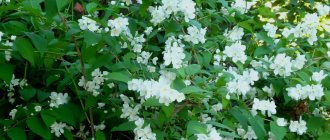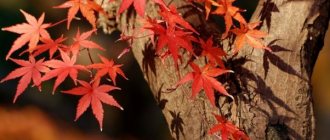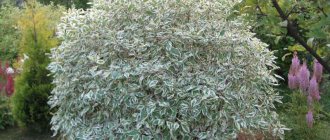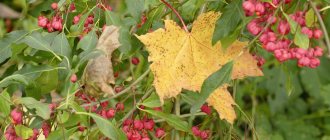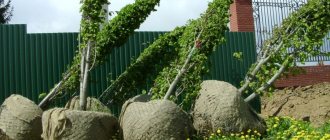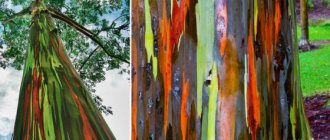High air temperatures coupled with low humidity are a real hell for ornamental and garden plants. Prolonged periods characterized by such “symptoms” are called drought. For most plants, nothing worse can be imagined, and even winter frost is not as terrible as prolonged thirst. However, in the encyclopedia of an experienced gardener there are many representatives of the flora that are ready to easily endure drought.
Therefore, if endless sunshine is a common occurrence in your region, check out the list of trees and shrubs presented below. Why torment plants that are not drought-resistant if they can be replaced at any time with those that are completely fearless in the summer sun?
yellow acacia
Yellow locust tops the list of the most drought-resistant shrubs and trees. It does not need fertilizer at all and thrives on sandy soil. Professionals recommend feeding exclusively young trees, because “elderly” representatives of this genus do not need additional nutrients at all.
The only thing that should never be forgotten when growing yellow acacia is the need to prune the tree. Pruning should be done twice a year. Otherwise, the bottom layer of the tree will become very exposed.
Aralia
Aralia has a rather unusual appearance, and this is where the secret of its decorativeness lies:
- trunks are perfectly straight and unbranched;
- the aralia along the entire length of the trunks is covered with large spines, visually reminiscent of pink thorns;
- The triply pinnate leaves are simply huge and can reach 100 cm in length.
Aralia blooms with paniculate inflorescences, which consist of cream-colored flowers. The flowers smell excellent, exuding aroma for several kilometers around them. Aralia cannot grow and develop without light. Long-term drought is much more attractive for her than a shady or semi-shady location. You only need to be careful when transplanting this representative of the flora: the process itself is not terrible for aralia, but its roots are quite fragile, so you need to be extremely careful not to damage them.
If you want to create an irresistible hedge in your garden, use aralia as the main plant in a single or group planting. And then not a single attacker will dare to overcome this plant fence.
Decorative trees and shrubs
The beautiful barberry shrub is a clear favorite due to its unpretentiousness and drought resistance. Its thorn-strewn stems, growing up to 1 meter high, are decorated with elegant yellow, pink-brown and bright red leaves.
Among the variety of barberry varieties, the most decorative ones are Golden Ring with small red leaves in a yellow border and Rose Glow with pink-brown leaves with a fancy pattern in the form of white strokes and droplets
Branched barberry shrubs love the sun, but can also grow in slightly shaded areas. Some varieties of barberry also delight you with edible bright red fruits in the fall.
You can learn more about how to use barberry in landscape design from the material: https://diz-cafe.com/rastenija/barbaris-posadka-i-uxod.html
Euonymus is a bright and unusually beautiful shrub, attractive with its beautiful openwork crown and small, elegant foliage.
The plant, whose foliage is a rich dark green in the summer months, is engulfed in an “autumn fire” as September approaches, turning into shades of orange, purple and violet.
The pinkish fruits that cover the stems of the euonymus open as they ripen, revealing bright red-orange seeds. Amazing sight! But it is worth remembering that ripe fruits, like all parts of the plant, are poisonous.
The silver oleagin shrub is no less decorative. It feels most comfortable on very depleted soils, enriching and improving them with nitrogen.
The branches of the shrub, decorated with silvery foliage, are strewn with miniature flowers during flowering, spreading a pleasant aroma, thanks to which they are widely used in the perfume industry
In place of the flowers, fruits are later set, which by autumn grow into yellowish berries with astringent, sweetish pulp.
Juniper is an absolutely undemanding and unusually beautiful forest guest that has long taken root in suburban areas.
The flexible branches of an evergreen shrub are decorated with tiny needles and scaly needles, spreading a pleasant resinous aroma around them.
An amazingly beautiful forest dweller, withstanding unfavorable conditions, is capable of transforming any place on the site. It will be an effective addition to a rocky garden, a multi-level flower garden, a mixborder, or a frame for a garden path.
Drought-resistant plants are ideal for garden and flower garden decoration. They take root well and serve as a worthy decoration for the site.
- Author: Maria Sukhorukikh
Rate this article:
- 5
- 4
- 3
- 2
- 1
(0 votes, average: 0 out of 5)
Share with your friends!
Birch
It is difficult to imagine a person who is not personally familiar with this symbol of Ukraine and Russia. Birch groves are a real asset of the middle zone. A gardener’s desire can easily turn a famous tree into an asset not only for his country, but also for his garden plot. It is pleasant to deal with birch, because this representative of the flora does not care how deep or close the groundwater lies. At the same time, it is not at all picky about the amount of moisture: if you have it, that’s good, if you don’t, that’s fine.
Before the movement of sap through the tree begins in the spring, the birch tree must be pruned. If this tree grows on your site, you should learn how to carry out sanitary pruning, as well as processing to form the crown.
Euonymus
The business card of the euonymus is its unusual fruits. They are presented in the form of leathery boxes, which are painted in one of the shades of red. The seeds of the plant are covered with a fleshy substance and look quite strange. The shrub is sensitive to shady locations and requires virtually no watering. Only one thing is important: that the soil in which the euonymus is planted is breathable. Aeration is the only criterion that is really worth analyzing before planting. Below is a short list of landscape design elements in which euonymus can be involved:
- rockery;
- rock garden;
- hedge;
- solitaire planting;
- group planting.
Euonymus is a poisonous plant (with the exception of a few species). In addition, the plant is often attacked by pests. The euonymus is most susceptible to the influence of the euonymus moth.
Privet
Privet is a family of plants that combines two types of shrubs:
evergreen;
- deciduous.
Privet is distinguished by its fruit, presented in the form of a drupe, visually reminiscent of a berry. The plant is not afraid of frost, drought, or heavy rains. It can grow even where the soil has a high lime content. What can we say, if privet is often found on saline soils, which are destructive for most plants.
Privet is ideal for creating composite hedges. The shrub is easy to trim and allows you to turn an ordinary and unremarkable crown into a masterpiece of landscape art of any shape.
Deytsia
If you want to plant something lushly blooming on your plot, be sure to take a closer look at the action. Surprisingly, this beautiful shrub is not afraid of pests and is completely indifferent to city smog. Smoke and exhaust gases are not capable of destroying it. Prolonged heat cannot do this either.
Dwarf varieties of deutia are most often used to create living borders. But ordinary types of plants can be used in the following landscape design objects:
- solitaire planting;
- group planting;
- hedge.
When pruning the deutia, do not forget that the flower formation is produced not in young, but in last year’s stems. Remember: the beautiful deutzia needs regular fertilization of the soil.
Drought-tolerant echinacea is a useful perennial
The main advantages of this highly decorative plant are durability and resistance to weather conditions. According to many gardeners, this is the most spectacular perennial, producing color in July-August.
Echinacea flowers resemble large multi-colored daisies with a convex core. The diameter of flower baskets ranges from 11-14 cm.
Echinacea is great for bouquets. In addition, by cutting flowers, you give the plant strength to form new buds. Bright “daisies” will delight you until autumn.
What does echinacea look like?
The best types and varieties:
- Echinacea strange is the only one of the genus that can boast a bright yellow color;
- Echinacea purpurea - meter-tall powerful bushes with dense foliage and bright purple inflorescences with a brown core;
- White Swan - greenish-yellow center edged with white petals;
- The king is two-meter “giants” with amazingly beautiful large (up to 15 cm) pinkish flowers;
- Cranberry muffin is a beautiful double variety with pink and purple flowers.
Many gardeners grow the plant not only for decorative purposes.
Echinacea is famous for its medicinal properties. Infusions and decoctions from it help fight colds and infections. Echinacea is included in many homeopathic and medicinal preparations.
The time for sowing seeds is late autumn or early spring. Planting material is sown directly into open ground without prior stratification. There is a possibility that out of the entire packet of seeds, only a few will be viable.
If you are not sure about the quality of the seeds, it is better to buy cuttings.
The plant feels better on calcareous or slightly alkaline dry nutrient soils. Before planting, the sandy soil is enriched with organic matter.
The bush grows in one place for three to four years.
For the winter, the bushes are pruned and covered with dry leaves.
Oak
We are all familiar with oak, as with birch, firsthand. The oak tree doesn’t care at all what the summer will be like. He is not the least bit afraid of the sun or the total heat that destroys everything around him. Oak can grow for a very long time. There are cases where this plant remained intact and unharmed after several hundred years. All long-lived oaks are protected by law and usually grow in places that are national reserves or protected areas.
It is extremely important for oak that the soil on which it grows is rich in vitamins, macro- and microelements. Otherwise, there can be no talk of longevity.
The main advantage of the tree is its root system, which has the shape of a rod and makes the plant wind-resistant.
Common thyme for an extraordinary flower garden
This wild type of thyme is, of course, inferior to decorative varieties: its foliage is not so lush, and it is not covered with a lush carpet on the ground. But it has one undeniable advantage: it is unpretentious and can grow in any conditions.
The plant self-sows abundantly and quickly spreads into a lacy blanket of delicate lilac fragrant flowers.
Thyme is not afraid of trampling and responds to every touch with a fragrant trail.
It can be used as a spice.
The best types and varieties:
Thyme prefers to grow in a sunny place, but will also take root well in the shade, although in this case it will stretch out and bloom weakly. The plant is suitable for both alkaline and neutral soils. The only thing thyme needs is pruning. In early spring, the bushes are cut down to the woody part, about two-thirds.
Karagana
The name “karagana” includes miniature trees and shrubs of deciduous type. The former are quite rare, while the latter are much more common. A distinctive feature of caraganas is their stipules, which, thanks to evolutionary processes over time, have turned into spines resembling an awl.
Caragana bears fruit with seeds hidden in pods. The type of soil for a plant does not matter much. It, like privet, agrees to grow and develop even on slightly saline soil. Caraganas are considered ideal plants for urban landscape design due to their indifference to smog and metropolitan gas pollution.
Standard forms of caragana are ideal plants for solitary plantings.
Sedums for a bright floral carpet
This is an excellent option for alpine slides. Such plants quickly grow in strength and look fresh, even when the grass turns yellow from the heat. During the flowering period, they are completely covered with bright inflorescences.
If you plant low varieties of sedum, it will seem as if the ground is covered with a flower mat.
Plants are decorative not only during the flowering period; their dense, thick leaves also look quite impressive.
What do sedums look like?
The best types and varieties:
- Sedum sedum - forms a low decorative green mat up to 7 cm high, looks especially impressive when covered with bright yellow flowers;
- Evers sedum is an excellent border sedum. The shoots are woody, the leaves are round with a blue tint. In August, small pink inflorescences appear;
- White sedum - it is better to plant on poor soils, otherwise the plant will quickly cover the entire ground with a low (up to 4 cm) carpet. During the flowering period, flower stalks rise, strewn with snow-white small and very fragrant flowers;
- Sedum reflexum grows in a bluish twenty-centimeter mat; at the beginning of summer, yellow flowers bloom on tall (up to 30 cm) peduncles.
Any well-drained soil containing compost or humus is suitable for growing sedums. The main care is to regulate the growth of the plant, otherwise the sedum may grow and occupy the entire flowerbed.
cotoneaster
Cotoneaster is distinguished by glossy shiny leaves, which are the hallmark of this plant. Cotoneasters are divided into two types:
- evergreen;
- deciduous.
Most often, these plants are used to form hedges. They are not afraid of frost and heat, and the moisture content in the soil is not important to them. As, indeed, is the type of soil. Cotoneasters can be pruned easily and with pleasure, allowing gardeners to create beauty with a light pressure on the handles of garden shears.
If an old bush is too overgrown and needs rejuvenation, trim it back as much as possible. The ideal period for pruning deciduous cotoneasters is the last month of winter. Evergreen cotoneasters are pruned in mid-spring, not earlier.
Euxerophytes
The category of true xerophytes includes representatives such as euxerophytes - these are plants that have the ability to sharply reduce transpiration under conditions of severe lack of moisture.
They have the following features:
- increased moisture retention capacity;
- reduced water content;
- increased elasticity of the cytoplasm.
These plants can suck moisture from almost dry soil. The leaves are covered with a layer of cuticle. This category includes various types of wormwood, acacia and other plants.
Siberian larch
Siberian larch is the real queen of the forest. In its natural habitat, the height of the tree can reach forty meters. In captivity it is, of course, much lower, but still quite large and majestic. A young larch is shaped like a narrow pyramid, but over the years the tree becomes more and more rounded - and in the end its original narrow pyramidality disappears without a trace.
This valuable tree species is used for organizing alleys and group plantings. But if the place allows you to plant only one larch, feel free to use this chance. As a tapeworm in a summer cottage, Siberian larch looks very impressive.
Don’t know how to complement the larch on your site? Plant seedlings of linden, fir, cypress or cedar next to it. Rhododendrons and junipers are considered ideal additions to this tree.
Loch
Loch is a beautiful tree or shrub that can be seen from afar. The peculiarity of this culture is the shoots, which seem to be covered with a silvery coating. When the sucker blooms, the whole neighborhood feels it. It exudes an unusual, quite pleasant, special aroma that cannot be confused with anything else. Loch is considered the best honey plant among its kind (among deciduous trees). If you plant a tree on your site, you can count on the fact that over time the soil under the plant will be renewed. The fact is that microorganisms that produce nitrogen live in the root system of the sucker. Therefore, under the tree and around it, you can safely plant garden crops that need this substance.
Snowberry
Snowberry is an ornamental shrub of the deciduous type. The plant is especially valued for its fruits, which are colored snow-white or pleasant pink. It is noteworthy that even with the arrival of winter frosts, the beautiful fruits do not lose color. They remain hanging on the bush until spring, which is especially pleasing to the eye of the beholder.
Snowberry loves sunlight. If you choose the right location for the shrub, it will begin to develop quickly and actively, quickly turning from a seedling into a full-fledged plant. Snowberry bushes look great in the landscape of large cities, because under the influence of smog and industrial gases they do not lose their attractiveness.
Snowberry loves lime-rich soil. He takes pruning calmly. After molding, it recovers quickly.
Decorating a flower bed in the sun
In order for a flowerbed in the sun to have a unified style, choose what to plant. In addition, the flower garden must comply with the rules:
- Minimalism. Plant a maximum of 3 varieties of plants per 1 m2 of area.
- Long-lived crops are preferable.
- The soloist occupies the central place and dominates the flowerbed.
- Color palette. The tones determine the style, thematic idea and wishes. The softness of the colors enhances the beauty of individual crops. The combination of blue and white shades has the effect of glowing from within, the violet-blue color gives off coldness and nobility, the pink tone gives off romanticism, the red-yellow color is responsible for the audacity and brightness of the images.
- Foliage is valued no less than flowers. Most of the crops are decorative and remain attractive with the arrival of the autumn season.
- Maintaining optical balance, softening contrasts.
- Spontaneous decisions are welcome.
- They prevent perennial crops from going wild and rejuvenate old bushes.
- Viability of perennials in the flower garden. Partners should not suppress each other.
- Candidates for the flower bed are selected according to the growing conditions.
- Follow the requirements for landing a single individual.
- Plan the design of the edge of the flower bed in advance. Low-growing varieties that cover clearings are suitable. Geranium, dwarf spirea, lungwort, and heuchera will help out.
Schemes of simple flower beds are:
- Permanent compositions with a clearly defined geometric pattern, where crops bloom at the same time and are separated from each other;
- Non-permanent compositions in which crops are grouped and the flowerbed fits into the garden decor. The order of flowering of perennials will increase the decorative life of the flower bed.
On a note! Regardless of the form, there is a main pattern in planting plants in a flower garden. In the center there are flashy and tall specimens, the middle part is the location of medium-sized specimens, and low perennial long-flowering plants or ornamental grass take place on the edge.
Lilac
Lilac is most often a deciduous plant. Evergreen shrubs are extremely rare among lilac varieties. Although, of course, you can find them if you want. The advantage of lilac is its fragrant, fragrant flowers, which mark the middle or end of May (depending on the region where the tree grows). The colors of flowers may differ: white, pink, purple, lilac, burgundy - and these are not all “lilac” shades.
The benefits of lilac are as follows:
- indifference to frost;
- fear of air pollution;
- calm attitude towards the abundance of dust;
- no fear of drought.
Landscape designers create beautiful hedges from lilac bushes. Trees are often planted near artificial ponds on a personal plot. Lilac is good both as a tapeworm and as a participant in group plantings.
Poylyloxerophytes
During periods of drought, these plants enter a state of anabiosis, in which metabolism proceeds at a slow pace.
This category includes ferns, some types of lichens, and some angiosperms. When the rainy season arrives, they return to their normal state.
Knowledge of the ecological properties of herbs allows you to:
- sow on forage lands those types of grass mixtures that correspond to the environmental conditions of the habitat;
- using agrotechnical measures to optimize environmental conditions for different types of grasses;
- have an understanding of the ecological characteristics of a habitat based on the plants growing on it.
There are many attempts by plant breeders to make plants more resistant to drought. In particular, they take into account the specifics of xerophytes, their structural features, and metabolic processes. This work makes it possible to obtain varieties that are resistant to unfavorable growing conditions.
Agro offers special drought-resistant grass mixtures, which are the best option for regions with arid climates. The main type of grass used in such mixtures is red fescue, which is characterized by strong adaptability to different growing conditions. Breeders have developed a number of varieties that are specially adapted to the southern regions, i.e. they can withstand long periods of drought. Lawns sown with these grasses retain their lush green color even when the surrounding vegetation is completely burned out by the sun.
Rose (rose hip)
The height of rose bushes can vary dramatically from variety to variety. Some roses never grow above 20 cm, while others easily surpass the 100 cm mark. The ancestor of roses is considered to be the rose hip. But unlike it, modern varietal rose bushes are remontant plants, that is, those that are able to pamper a summer resident with their beauty several times a season.
Roses are not afraid of drought. Excessive waterlogging of the soil can have much more dire consequences for the queen of flowers. Wetting the root system is a step towards diseases and parasites that can destroy the plant. If roses grow in temperate latitudes, they must be covered during the winter. Professionals who know a lot about growing these flowers recommend feeding them regularly. Otherwise, over time, beautiful flowers will be crushed and become less attractive.
Most often, roses are used to create rosaries. However, they can often be found as part of decorative borders and hedges.
Carnation
Carnations will become a real decoration of the garden all summer long. Dry-loving plants bloom for a long time and are unpretentious to soil and watering.
Flowers have different sizes, shapes and shades. But most varieties of carnations bloom in bright red, pink or two-tone colors.
Carnation: YouTube/Everyone can do it!
They are grown as a perennial, but without renewal the bushes quickly age. Therefore, in the spring, carnations are sown with seeds in the flowerbed. In the first year, the plant develops leaves, and in the second year, flower stalks appear.
Cloves also reproduce in other ways:
- seedlings;
- dividing bushes;
- cuttings;
- rooting cuttings.
Thanks to the timely renewal of plants, a flower bed with carnations blooms every year.
Locust
And finally, the most drought-tolerant plant on this list. Robinia is absolutely indifferent to the sun. It can spend a long time without water and still not lose a bit of its attractiveness. Robinia can be planted on any soil. But if the soil is too heavy or too wet, be prepared for the fact that a representative of the flora may suffer during frost or a seasonal drop in air temperature.
Robinia survives transplantation to another location and seasonal pruning quite calmly. Sandy loam soils are considered ideal for the plant. Therefore, if you have the opportunity, please the beauty with your choice of soil.
Read: Unusual cereal plants to decorate your garden
Join our Facebook group
Lupine
The flowerbed will be decorated with drought-resistant perennial lupine flowers (“wolf beans”), blooming twice a season. A plant from the legume family is sown with seeds in May or autumn.
In the first year, only bushes with beautiful palmate leaves appear. Powerful flowering shrubs grow in 1.5–2 years if planted in islands.
Lupine: YouTube/Fun Gardening
Caring for lupine is not difficult:
- Plant bushes one by one or in groups in slightly acidic soil.
- The stems are cut off after flowering so that by autumn there will be new branches.
- Watering is carried out during the period of germination and rooting of seedlings.
- Mineral fertilizers are applied before flowering.
Lupine blooms in long racemes covered with irregularly shaped flowers. The length of the inflorescences reaches from 50 cm to 1 m. The flowers have different colors from white to purple. The flowerbed produces a unique mix of shades.

